Atlético Madrid
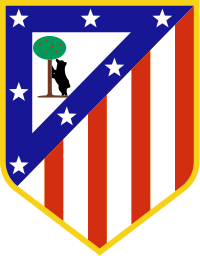 | |||
| Full name | Club Atlético de Madrid, S.A.D. | ||
|---|---|---|---|
| Nickname(s) |
| ||
| Founded | 26 April 1903 as Athletic Club de Madrid | ||
| Ground | Vicente Calderón Stadium | ||
| Capacity | 54,960[1] | ||
| Owner |
Miguel Ángel Gil Marín (52%) Enrique Cerezo (20%) Wang Jianlin (Wanda Group) (20%)[2] | ||
| President | Enrique Cerezo | ||
| Manager | Diego Simeone | ||
| League | La Liga | ||
| 2015–16 | 3rd | ||
| Website | Club home page | ||
|
| |||
| Active departments of Atlético Madrid | ||||||||||||
|---|---|---|---|---|---|---|---|---|---|---|---|---|
|
Club Atlético de Madrid, SAD (Spanish pronunciation: [ˈkluβ aðˈletiko ðe maˈðɾið]) commonly known as Atlético Madrid, or simply as Atlético, is a Spanish professional football club based in Madrid, that plays in La Liga.
In terms of UEFA competition titles won, Atlético Madrid is Spain's third most successful club behind Real Madrid and Barcelona. In terms of the number of titles, Atlético Madrid is the fourth most successful club in Spanish football, behind Barcelona, Real Madrid and Athletic Bilbao. Atlético have won La Liga on ten occasions, including a league and cup double in 1996; the Copa del Rey on ten occasions; two Supercopas de España and one Copa Eva Duarte; in Europe, they won the European Cup Winners' Cup in 1962, were runners-up in 1963 and 1986, were European Cup runners-up in 1974, 2014 and 2016,[3] won the Europa League in 2010 and in 2012, won the UEFA Super Cup in 2010 and 2012, as well as the 1974 Intercontinental Cup.
The club play their home games at the Vicente Calderón,[4] which holds up to 54,960 spectators. In 2016, Atlético are due to move to their new home of Estadio La Peineta, which will have a capacity of 70,000. Atlético's home kit is red and white vertical striped shirts, with blue shorts, accompanied by blue and red socks. This combination has been used since 1911.
During their history the club has been known by a number of nicknames, including Los Colchoneros ("The Mattress Makers"), due to their first team stripes being the same colours as old-fashioned mattresses. During the 1970s, they became known as Los Indios, allegedly due to the club signing several South American players after the restrictions on signing foreign players were lifted. However, there are a number of alternative theories which claim they were named so because their stadium is "camped" on the river bank, or because Los Indios (The Indians) were the traditional enemy of Los Blancos (The Whites), which is the nickname of the club's city rivals, Real Madrid.[5]
Felipe VI, the current king of Spain, has been the honorary president of the club since 2003. The club co-owns the Indian Super League franchise in Kolkata, named Atlético de Kolkata, which won the inaugural season of the competition in 2014.
History
Foundation and first years (1903–1939)
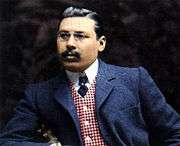
The club was founded on 26 April 1903[6] as Athletic Club de Madrid by three Basque students living in Madrid. These founders saw the new club as a youth branch of their childhood team, Athletic Bilbao.[6] In 1904, they were joined by dissident members of Real Madrid.[7] They began playing in blue and white, similarly to Athletic Bilbao, but by 1911, Athletic were playing in their current colours of red and white stripes. Many believe the change was influenced because red and white striped tops were the cheapest stripes to make, because the same combination was used to make bed mattresses, and the unused cloth was easily converted into football shirts. This discovery of a cheaper option probably persuaded them to change and influenced the Madrid club being come to known as Los Colchoneros nickname. Another more plausible account of the reason to change colours is that both Athletic Bilbao and Athletic Madrid used to buy Blackburn Rovers blue and white kits in England.[8] Once in 1911, Juanito Elorduy, former player and member of the board of Athletic Madrid, went to England to buy kits for both teams. When he failed to find Blackburn Rovers kits to purchase, he instead bought Southampton red and white ones. Athletic Madrid adopted the red and white shirt but opted to keep Blackburn Rovers' blue shorts, leading to them also being known as Los Rojiblancos.
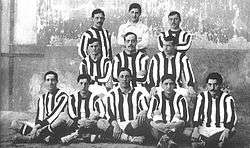
Atlético's first ground, the Ronda de Vallecas, was situated in the eponymous working-class area on the south side of the city. In 1919, the Compañía Urbanizadora Metropolitana—the company that ran the underground communication system in Madrid—acquired some land, near the Ciudad Universitaria. And in 1921, Athletic Madrid became independent of parent-club Athletic Bilbao. As part of that project the company built a sports stadium, named Estadio Metropolitano de Madrid, and Athletic had a new a 35,800-seat home.[9] The Metropolitano was used until 1966, when they moved to the new Estadio Vicente Calderón.[10] After the move, the Metropolitano was demolished and was replaced with university buildings and an office block belonging to the company ENUSA.
During the 1920s, Athletic won the Campeonato del Centro three times and were Copa del Rey runners-up in 1921; ironically, this final saw them face parent club Athletic Bilbao, as well as later in 1926. Based on this record, they were invited to join the Primera División of the inaugural La Liga in 1928. During their debut La Liga season, the club were managed by Fred Pentland, but after two seasons in the Primera División they were relegated to Segunda División. They briefly returned to La Liga in 1934 but were relegated again in 1936 after Josep Samitier took over in mid-season from Pentland. Fortunately for Los Colchoneros, the Spanish Civil War gave the club a reprieve, as Real Oviedo was unable to play due to the destruction of their stadium during the bombings. Thus, both La Liga and Athletic's relegation were postponed, the latter by winning a playoff against Osasuna, champion of the Segunda División tournament.
Athletic Aviación de Madrid (1939–1947)
By 1939, when La Liga had resumed, Athletic had merged with Aviación Nacional of Zaragoza to become Athletic Aviación de Madrid. Aviación Nacional had been founded in 1939 by members of the Spanish Air Force. They had been promised a place in the Primera División for the 1939–40 season, only to be denied by the RFEF. As a compromise, this club merged with Athletic, whose squad had lost eight players during the Civil War. The team were awarded a place in the 1939–40 La Liga campaign only as a replacement for Real Oviedo. With the legendary Ricardo Zamora as manager, the club subsequently won their first La Liga title that season and retained the title in 1941. The most influential and charismatic player of these years was the captain Germán Gómez, who was signed from Racing de Santander in 1939. He played eight consecutive seasons for the Rojiblancos until the 1947–48 campaign. From his central midfield position, he formed a legendary midfield alongside Machín and Ramón Gabilondo. In 1941, a decree issued by Francisco Franco[11] banned teams from using foreign names and the club became Atlético Aviacion de Madrid. In 1947, the club decided to drop the military association from its name and settled on its current name of Club Atlético de Madrid. The same year saw Atlético beat Real Madrid 5–0 at the Metropolitano, their biggest win over their cross-town rivals to date.[12]
The Golden Age (1947–1965)
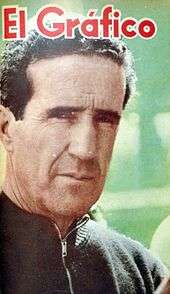
Under Helenio Herrera and with the help of Larbi Benbarek, Atlético won La Liga again in 1950 and 1951. With the departure of Herrera in 1953, the club began to slip behind Real Madrid and Barcelona and for the remainder of the 1950s were left to battle it out with Athletic Bilbao for the title of third team in Spain.
However, during the 1960s and 1970s, Atlético Madrid seriously challenged Barcelona for the position of second team. The 1957–58 season saw Ferdinand Daučík take charge of Atlético, where he led them to second place in La Liga. This resulted in Atlético qualifying for the 1958–59 season of the European Cup since the winners, Real Madrid, were the reigning European champions. Inspired by Brazilian centre-forward Vavá and Enrique Collar, Atlético reached the semi-finals after beating Drumcondra, CSKA Sofia and Schalke 04.[13] In the semi-finals, they met Real Madrid, who won the first leg 2–1 at the Santiago Bernabéu while Atlético won 1–0 at the Metropolitano.[14] The tie went to a replay and Real won 2–1 in Zaragoza.[15]
Atlético, however, gained their revenge when, led by former Real coach José Villalonga, they defeated Real in two successive Copa del Rey finals in 1960 and 1961. In 1962, they won the European Cup Winners' Cup, beating Fiorentina 3–0 after a replay.[16] This achievement was significant for the club, as the Cup Winners' Cup was the only major European trophy that Real Madrid never won. The following year the club reached the 1963 final, but lost to English side Tottenham Hotspur 5–1.[17] Enrique Collar,[18] who continued to be an influential player during this era, was now joined by the likes of midfielder Miguel Jones and midfield playmaker Adelardo.[19]
Atlético's best years coincided with dominant Real Madrid teams. Between 1961 and 1980, Real Madrid dominated La Liga, winning the competition 14 times. During this era, only Atlético offered Real any serious challenge, winning La Liga titles in 1966, 1970, 1973 and 1977 and finishing runners-up in 1961, 1963 and 1965. The club had further success winning the Copa del Rey on three occasions in 1965, 1972 and 1976. In 1965, when they finished as La Liga runners-up to Real after an intense battle for the title, Atlético became the first team to beat Real at the Bernabéu in eight years.
European Cup Finalists (1965–1974)
Significant players from this era included the now-veteran Adelardo and regular goalscorers Luis Aragonés, Javier Irureta and José Eulogio Gárate, the latter winning the Pichichi three times in 1969, 1970 and 1971. In the 1970s, Atlético also recruited several Argentine personnel, signing Rubén Ayala, Panadero Díaz and Ramón "Cacho" Heredia as well as coach Juan Carlos Lorenzo. Lorenzo believed in discipline, caution and disrupting the opponents' game, and although controversial, his methods proved successful—after winning La Liga in 1973, the club reached the 1974 European Cup Final.[20] On the way to the Final, Atlético knocked out Galatasaray, Dinamo Bucureşti, Red Star Belgrade and Celtic.[21] In the away leg of the semi-final against Celtic, Atlético had Ayala, Díaz, and substitute Quique all sent off during a hard-fought encounter in what was reported as one of the worst cases of cynical fouling the tournament has seen. Because of this cynicism, they managed a 0–0 draw, which was followed by a 2–0 victory in the return leg with goals from Gárate and Adelardo.[22] The Final at Heysel Stadium, however, was a loss for Atlético. Against a Bayern Munich team that included Franz Beckenbauer, Sepp Maier, Paul Breitner, Uli Hoeneß and Gerd Müller, Atlético played above themselves. Despite missing Ayala, Díaz and Quique through suspension, they went ahead in extra-time with only seven minutes left. Aragonés scored with a superb, curling free-kick that looked like the winner, but in the last minute of the game, Bayern defender Georg Schwarzenbeck equalized with a stunning 25-yarder that left Atlético goalkeeper Miguel Reina motionless.[23] In a replay back at Heysel two days later, Bayern won convincingly 4–0, with two goals each from Hoeneß and Müller.[23]
The Aragonés years (1974–1987)

Shortly after the defeat in the European Cup, Atlético appointed their veteran player Luis Aragonés as coach. Aragonés subsequently served as coach on four separate occasions, from 1974 to 1980, from 1982 to 1987 once again 1991 until 1993 and finally from 2002 to 2003. His first success came quickly as Bayern Munich had refused to participate because of fixture congestion[24] in the Intercontinental Cup and as European Cup runners-up, Atlético were invited instead. Their opponents were Independiente[24] of Argentina and, after losing the away leg 1–0, they won the return leg 2–0 with goals from Javier Irureta and Rubén Ayala.[25] Aragonés subsequently led the club to further successes in the Copa del Rey in 1976 and La Liga in 1977.
During his second spell in charge, Aragonés led the club to a runners-up finish in La Liga and a winner's medal in the Copa del Rey, both in 1985. He received considerable help from Hugo Sánchez, who scored 19 league goals and won the Pichichi. Sánchez also scored twice in the cup final as Atlético beat Athletic Bilbao 2–1. Sánchez, however, only remained at the club for one season before his move across the city to Real Madrid. Despite the loss of Sánchez, Aragonés went on to lead the club to success in the Supercopa de España in 1985 and then guided them to the European Cup Winners' Cup final in 1986. Atlético, however, lost their third successive European final, this time 3–0 to Dynamo Kyiv.[26][27]
The Jesús Gil years (1987–2003)

In 1987, controversial politician and businessman Jesús Gil became club president, running the club until his resignation in May 2003.[28]
Atlético had not won La Liga for ten years and were desperate for league success. Right away, Gil spent heavily, bringing in a number of expensive signings, most notably Portuguese winger Paulo Futre, who had just won the European Cup with Porto.[29] All the spending, however, only brought in two consecutive Copa del Rey trophies in 1991 and 1992 as the league title proved elusive. The closest Atlético came to the La Liga trophy was the 1990–91 season when they finished runners-up by ten points to Johan Cruyff's Barcelona. In the process, Gil developed a ruthless reputation due to the manner in which he ran the club. In pursuit of league success, he hired and fired a number of high-profile head coaches, including César Luis Menotti, Ron Atkinson, Javier Clemente, Tomislav Ivić, Francisco Maturana, Alfio Basile as well as club legend Luis Aragonés.
Gil also closed down Atlético's youth academy in 1992,[30] a move that would prove significant due to 15-year-old academy member Raúl who, as a result, went across town to later achieve worldwide fame with rivals Real Madrid.[31] The move came as part of the overall Gil-initiated business restructuring of the club; Atlético became a Sociedad Anónima Deportiva, a corporate structure benefiting from a then-recently introduced special legal status under Spanish corporate law, allowing individuals to purchase and trade club shares.
In the 1994–95 league campaign, Atlético only avoided relegation via a draw on the last day of the season. This prompted another managerial change along with a wholesale squad clearance during the summer 1995 transfer window. Somewhat unexpectedly, in the following 1995–96 season, newly arrived head coach Radomir Antić, with a squad including holdovers Toni, Roberto Solozábal, Delfí Geli, Juan Vizcaíno, José Luis Caminero, Diego Simeone and Kiko, as well as new acquisitions Milinko Pantić, Luboslav Penev, Santi Denia and José Francisco Molina finally delivered the much sought-after league title as Atlético won the La Liga/Copa del Rey double.[6]
The next season, 1996–97, saw the club take part in the Champions League for the first time. With expectations and ambitions raised, the most notable summer transfer signings were striker Juan Esnáider from Real Madrid and Radek Bejbl, who was coming off a great showing for Czech Republic at Euro 1996. Playing on two fronts, Atlético fell out of the league title contention early while, in the Champions League, they were eliminated by Ajax in extra-time in the quarter-finals. Before the 1997–98 season, the heavy spending continued with the signings of Christian Vieri and Juninho. All of the success, however, produced little change in the overall Gil strategy, and although Antić survived three consecutive seasons in charge, he was replaced during the summer of 1998 with Arrigo Sacchi, who himself only remained in the managerial hot seat for less than six months. Antić then returned briefly in early 1999 only to be replaced with Claudio Ranieri at the end of the season. The 1999–2000 season proved disastrous for Atlético. In December 1999, Gil and his board were suspended pending an investigation into the misuse of club funds, with government-appointed administrator José Manuel Rubí running Atlético's day-to-day operations. With the removal of club President Jesús Gil and his board, the players performed poorly and the club floundered. Ranieri handed in his resignation with the club sitting 17th out of 20 in the league table and heading towards relegation. Antić, returning for his third coaching stint, was unable to prevent the inevitable. Despite reaching the Copa del Rey final, Atlético were relegated.[32]
Atlético spent two seasons in the Segunda División, narrowly missing out on promotion in 2001 before winning the Segunda División championship in 2002. It was again Luis Aragonés, in his fourth and last spell as manager of Atlético, who brought them back to the Primera División.[33] He also coached the team during the next season, and gave Fernando Torres his La Liga debut.[34]
Aguirre era (2006–2009)
In 2006, Atlético signed Portuguese midfielders Costinha and Maniche, as well as Argentine forward Sergio Agüero. In July 2007, Fernando Torres left the club for Liverpool for £26.5 million,[35] while Luis García moved in the opposite direction at the same time in an unrelated transfer.[35] The club also bought Uruguay international and former European Golden Boot/Pichichi winner Diego Forlán for roughly €21 million from Villarreal.[36] Other additions included Portuguese winger Simão from Benfica and winger José Antonio Reyes for €12 million.[37][38]
In July 2007, the Atlético board reached an agreement with the City of Madrid to sell the land where their stadium is located and move the club to the City-owned Olympic Stadium. However, the new stadium will change hands in 2016 and be owned by the club. Madrid had applied to host the 2016 Olympic Games, losing out to Rio de Janeiro.[39]
The 2007–08 season proved to be the most successful season for the club in the past decade. The team reached the round of 32 in the UEFA Cup, where they were defeated by Bolton Wanderers. They also reached the quarter-final round of the Copa del Rey, where they were beaten by eventual champions Valencia. More significantly, the team finished the Liga season in fourth place, qualifying for the Champions League for the first time since the 1996–97 season.[40]

On 3 February 2009, Javier Aguirre was dismissed from his post as manager after a poor start to the season, going without a win in six games. He later claimed that this was not accurate, and that he had left by mutual termination rather than through sacking.[41] There was public outrage after his dismissal, many believing he was not the cause of Atlético's problems, namely player Diego Forlán. He backed his former manager and said that, "Dismissing Javier was the easy way out, but he was not the cause of our problems. The players are to blame because we have not been playing well and we have been committing a lot of errors." This led to the appointment of Abel Resino as Atlético's new manager.[42]
Atlético's success continued in the latter half of the season when they placed fourth once again in the league table, securing a position in the playoff round of the UEFA Champions League. Striker Diego Forlán was crowned with the Pichichi Trophy and also won the European Golden Shoe after scoring 32 goals for Atlético that season.[43] Atlético saw this domestic success as an opportunity to reinforce their squad for the upcoming Champions League season. They replaced veteran goalkeeper Leo Franco with David de Gea from the youth ranks and signed promising youngster Sergio Asenjo from Real Valladolid. Atlético also purchased Real Betis defender and Spanish international Juanito on a free transfer. Despite pressure from big clubs to sell star players Agüero and Forlán, Atlético remained committed to keeping their strong attacking base in the hopes for a successful new season.
The 2009–10 Atlético season, however, began poorly with many defeats and goals conceded. On 21 October, Atletico were hammered 4–0 by English club Chelsea in the Champions League group stage.[44] This defeat led Atletico's management to announce that manager Abel Resino had to leave.[45] After failing to sign Danish former footballer Michael Laudrup, Atlético Madrid made it official that the new manager for the rest of the season would be Quique Sánchez Flores.[46][47]
La Liga and European successes (2009–)
With the arrival of Quique Sánchez Flores as coach in October 2009, Atlético saw a huge change of fortunes. Though they continued to lag somewhat in La Liga during the 2009–10 season, finishing in the ninth position, they managed to get third place in the 2009–10 UEFA Champions League group stage and subsequently entered the season's Europa League in the round of 32, going on to win the Europa League, beating English teams Liverpool in the semi-finals and eventually Fulham[48] in the final held in the HSH Nordbank Arena in Hamburg on 12 May 2010.[49][50] Diego Forlán scored twice, the second being an extra-time winner in the 116th minute, as Atlético Madrid won 2–1.[51]
It was the first time since the 1961–62 European Cup Winners' Cup that Atlético had claimed a European title. They also reached the Copa del Rey Final on 19 May 2010, where they faced Sevilla, but lost 2–0 at the Camp Nou in Barcelona.[52] By winning the Europa League, they qualified for the 2010 UEFA Super Cup against Internazionale, winner of the 2009–10 UEFA Champions League, which was played in Monaco on 27 August 2010. Atlético won 2–0 with goals from José Antonio Reyes and Sergio Agüero, Atlético's first win in the Super Cup.
Atlético had a comparatively disappointing 2010–11 season, finishing only seventh in the League and being eliminated in the quarter-finals of the Copa del Rey and the Group Stage of the Europa League. This ultimately led to the departure of manager Sánchez Flores before the conclusion of the season, who was replaced with ex-Sevilla manager Gregorio Manzano, and who secured the final Europa League place for Atlético. Manzano himself was replaced with Diego Simeone in December 2011 after a poor run of form in La Liga.
Simeone led Atlético to their second Europa League win in the three years since its creation, as they beat Athletic Bilbao 3–0 in the final on 9 May 2012 in Bucharest with Radamel Falcao—twice—and Diego being the scorers.[53][54] Again, by winning the Europa League, they qualified for the 2012 UEFA Super Cup against Chelsea, winner of the previous season's Champions League, which was played in Monaco on 31 August 2012. Atlético won 4–1, including a hat-trick by Falcao in the first half. On 17 May 2013, Atlético beat Real Madrid 2–1 in the Copa del Rey Final in a tense match where both teams finished with ten men. This ended a 14-year and 25-match winless streak in the Madrid derby. The 2012–13 season saw the club finish with three trophies in a little over a year.[55][56]
As the undefeated winners of their Champions League group containing Zenit Saint Petersburg, Porto and Austria Wien, and later defeating Milan, Barcelona and Chelsea in the knock-out rounds, Atlético played their first Champions League Final since 1974, in Lisbon's Estádio da Luz against city rivals Real Madrid.[57][58] Atlético took a first-half lead through Diego Godín and survived Real's pressure until the third minute of injury time, when Sergio Ramos scored an equaliser from a corner. The match went into extra time and ended in a 4–1 loss. Atlético, however, did have the consolation of winning La Liga for the first time since 1996, with Godín's headed equaliser against Barcelona on the last day of the season, a week before the Champions League Final.[59]
Madrid derby

Real Madrid and Atlético Madrid are clubs with contrasting identities and different fates. While Real Madrid's Santiago Bernabéu Stadium proudly rises on Paseo de la Castellana in the wealthy Chamartín neighbourhood of northern Madrid, Atlético's less glamorous Vicente Calderón Stadium stands in the south of Madrid, in the working class barrio of Arganzuela. Historically, Real Madrid have long been seen as the establishment club. On the other side, the Rojiblancos were always characterized by a sentimiento de rebeldía, a sense of rebellion, although during the early Francisco Franco years, it was Atlético that was the preferred team of the regime, albeit forcibly. They were associated with the military airforce (renamed Atlético Aviación), until the regime's preferences moved towards Real Madrid in the 1950s.
Certainly, the dictatorial state sought to make political capital out of Real Madrid's European Cup trophies at a time when Spain was internationally isolated; "Real Madrid are the best embassy we ever had", said Franco's foreign minister Maria de Castiella.[60] Such perceptions have had an important impact on the city's footballing identities, tapping into the collective consciousness. In this vein, Atlético fans were probably the originators, and are the most frequent singers, of the song, sung to the tune of the Real Madrid anthem, "Hala Madrid, hala Madrid, el equipo del gobierno, la vergüenza del país", "Go Madrid, go Madrid, the government's team, the country's shame."
Until recently, Atlético Madrid had struggled significantly in the derby, carrying a 14-year winless streak into the 2012–13 season. This spell ended, however, on 17 May 2013 after Atlético beat their city rivals 2–1 at the Santiago Bernabéu to take home the Copa del Rey, and continued on 29 September 2013 when they won a 1–0 victory, again at the Bernabéu.
Honours
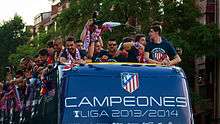
Domestic competitions
- Winners (10): 1939–40, 1940–41, 1949–50, 1950–51, 1965–66, 1969–70, 1972–73, 1976–77, 1995–96, 2013–14
- Winners (1): 2001–02
- Winners (10): 1959–60, 1960–61, 1964–65, 1971–72, 1975–76, 1984–85, 1990–91, 1991–92, 1995–96, 2012–13
- Copa de los Campeones de España (Predecessor to the Supercopa de España)
- Winners (1): 1940
- Copa Presidente FEF (Predecessor to the Supercopa de España)
- Winners (1): 1941(1947)
- Copa Eva Duarte (Predecessor to the Supercopa de España) [64]
- Winners (1): 1951
European competitions
International competitions
- Winners (1): 1974
Players
Current squad
- As of 31 August 2016[68]
Note: Flags indicate national team as defined under FIFA eligibility rules. Players may hold more than one non-FIFA nationality.
|
|
Out on loan
Note: Flags indicate national team as defined under FIFA eligibility rules. Players may hold more than one non-FIFA nationality.
|
|
Staff
Technical staff
| Position | Staff |
|---|---|
| Manager | |
| Assistant Coach | |
| Goalkeeper Coach | |
| Fitness Coach | |
| Head of Medical Department | |
| Club Doctor | |
Source:Atlético Madrid
Managers
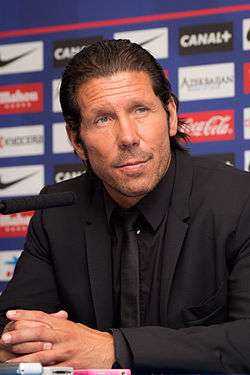
| The following managers won at least one trophy while in charge of Atlético Madrid | ||||
| Name | Period | Trophies | ||
|---|---|---|---|---|
| 1939–46 | 2 La Liga, Supercopa de España | |||
| 1946–48 | Copa Presidente FEF | |||
| 1949–53 | 2 La Liga, Supercopa de España | |||
| 1960–62 | 2 Copa del Rey, UEFA Cup Winners' Cup | |||
| 1964–65 | Copa del Rey | |||
| |
1965–66 | La Liga | ||
| 1969–72, 1979–80 | La Liga | |||
| 1971–73 | La Liga, Copa del Rey | |||
| 1974–80, 1982–87, 1991–93, 2001–03 | Intercontinental Cup, La Liga, 3 Copas del Rey, Supercopa de España, Segunda División, Iberian Cup | |||
| 1990–91 | Copa del Rey | |||
| 1995–98 | La Liga, Copa del Rey | |||
| 2009–11 | UEFA Europa League, UEFA Super Cup | |||
| 2011– | UEFA Europa League, UEFA Super Cup, La Liga, Copa del Rey, Supercopa de España | |||
Presidents
- 1. Enrique Allende (1903)
- 2. Eduardo de Acha (1903–07)
- 3. Ricardo de Gondra (1907–09)
- 4. Ramón de Cárdenas (1909–12)
- 5. Julián Ruete (1912–19)
- 6. Álvaro de Aguilar (1919–20)
- 7. Julián Ruete (1920–23)
- 8. Juan de Estefanía (1923–26)
- 9. Luciano Urquijo (1926–31)
- 10. Rafael González (1931–35)
- 11. José L. del Valle (1935–36)
- 12. José María Fernández (1936–39)
- 13. Francisco Vives (1939)
- 14. Luis Navarro (1939–41)
- 15. Manuel Gallego (1941–45)
- 16. Juan Touzón (1946–47)
- 17. Cesáreo Galindez (1947–52)
- 18. Marqués de la Florida (1952–55)
- 19. Jesús Suevos (1955)
- 20. Javier Barroso (1963–64)
- 21. Vicente Calderón (1964–80)
- 22. Ricardo Irezábal (1980)
- 23. Alfonso Cabeza (1980–82)
- 24. Antonio del Hoyo (1982)
- 25. Agustín Cotorruelo (1982)
- 26. Vicente Calderón (1982–87)
- 27. Francisco Castedo (1987)
- 28. Jesús Gil (1987–2003)
- 29. Enrique Cerezo (2003–)
Current Board
- President: Enrique Cerezo Torres.
- Chief Executive Officer: Miguel Ángel Gil Marín. Owner of the club, he holds 56% of the stock. He is the son of Jesús Gil.[69]
Recent seasons
Season Div. Pos. Pl. W D L GF GA Pts Cup Europe Notes 1987–88 1D 3rd 38 19 10 9 60 38 48 Quarter-final 1988–89 1D 4th 38 19 8 11 69 45 46 Semi-final UC Round of 64 1989–90 1D 4th 38 20 10 8 55 35 50 Round of 16 UC Round of 64 1990–91 1D 2nd 38 17 13 8 52 28 47 Winner UC Round of 64 1991–92 1D 3rd 38 24 5 9 67 35 53 Winner CWC Quarter-final Final Supercopa 1992–93 1D 6th 38 16 11 11 52 42 43 Round of 16 CWC Semi-final Final Supercopa 1993–94 1D 12th 38 13 9 16 54 54 35 Round of 16 UC Round of 32 1994–95 1D 14th 38 13 9 16 56 54 35 Quarter-final 1995–96 1D 1st 42 26 9 7 75 32 87 Winner First double in Club's history 1996–97 1D 5th 42 20 11 11 76 64 71 Quarter-final UCL Quarter-final Final Supercopa 1997–98 1D 7th 38 16 12 10 79 56 60 Round of 16 UC Semi-final Vieri won the Pichichi Trophy with 24 goals. 1998–99 1D 13th 38 12 10 16 54 50 46 Final UC Semi-final 1999–2000 1D 19 38 9 11 18 48 64 38 Final UC Round of 16 Relegated to 2nd Division 2000–01 2D 4th 42 21 11 10 59 39 74 Semi-final 2001–02 2D 1st 42 23 10 9 68 44 79 Round of 64 Promoted to 1st Division 2002–03 1D 11th 38 12 11 15 51 56 47 Quarter-final 2003–04 1D 7th 38 15 10 13 51 53 55 Quarter-final 2004–05 1D 11th 38 13 11 14 40 34 50 Semi-final Final UEFA Intertoto Cup 2005–06 1D 10th 38 13 13 12 45 37 52 Round of 16 2006–07 1D 7th 38 17 9 12 46 39 60 Round of 16 2007–08 1D 4th 38 19 7 12 66 47 64 Quarter-final UC Round of 32* 2008–09 1D 4th 38 20 7 11 80 57 67 Round of 16 UCL Round of 16 Forlán won the Pichichi and Golden Shoe with 32 goals. 2009–10 1D 9th 38 13 8 17 57 61 47 Final UEL Winner UCL – Out in Group stage 2010–11 1D 7th 38 17 7 14 62 53 58 Quarter-final UEL Group stage Win UEFA Super Cup 2011–12 1D 5th 38 15 11 12 53 46 56 Round of 32 UEL Winner 12 wins in a row in European competitions 2012–13 1D 3rd 38 23 7 8 65 31 76 Winner UEL Round of 32 Win UEFA Super Cup 2013–14 1D 1st 38 28 6 4 76 25 90 Semi-final UCL Final Final Supercopa 2014–15 1D 3rd 38 23 9 6 67 29 78 Quarter-final UCL Quarter-final Win Supercopa 2015–16 1D 3rd 38 28 4 6 63 18 88 Quarter-final UCL Final
Note: Athletico reached the 2008–08 UEFA Cup Round of 32 as qualified from the UEFA Intertoto Cup.
Stadium information
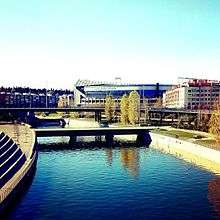
The club play their home games at the 54,990[1] seat Estadio Vicente Calderón in southern Madrid. Before this, the club played originally at the Ronda de Vallecas until 1923. After the completion of the Estadio Metropolitano de Madrid in 1923, the club moved there until the Vicente Calderón was finished in 1966.
The club plan to move in 2017 to the renovated Estadio La Peineta,[70] which will be expanded from a 20,000 seat capacity to 73,000 after it was used for Madrid's failed bid to host the 2016 Summer Olympics. The Vicente Calderón will be demolished, and replaced by a waterfront park at the banks of the Manzanares River in Madrid.[71] The club's training ground is the Ciudad Deportiva Atlético de Madrid in Majadahonda, 20 km west of Madrid. The facility maintains grass and artificial patches as well as a gym. Both the senior and youth squads train there.[72]
Atlético also runs a sports academy at the Ciudad Deportiva del Nuevo Cerro del Espino in Majadahonda.
Kit
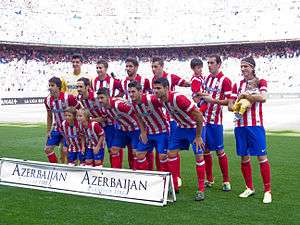
_01.jpg)
Atlético began playing in blue and white, similar to Athletic Betis, but soon changed to their traditional red and white stripes by 1911. Many believe the change was influenced because red and white striped tops were the cheapest stripes to make, as the same combination was used to make bed mattresses, and the unused cloth was easily converted into football shirts. The kit has been made by Nike for the past nine years, as the company wants to provide competition against Real Madrid, who have a deal with Adidas. The current shirt sponsor is Plus500, while Azerbaijan has a sponsor's logo on the back of the shirt. The shirt sponsorship by Azerbaijan has been condemned by Reporters Without Borders, who satirized it in a campaign visual in which the shirt's vertical stripes become prison bars with the logo "Azerbaijan, Land of Repression".[73] Atlético Madrid admits its sponsorship deal with Azerbaijan has a political dimension, saying the intention is to "promote the image of Azerbaijan".[74] In August 2014, the Helsinki Foundation for Human Rights wrote to Atlético, calling on it to end the sponsorship by and promotion of Azerbaijan because of Azerbaijan's human rights record, calling it "one of the most repressive countries in the world".[75]
Previously, the club was sponsored by Columbia Pictures, who would change the shirt sponsor's logo, and occasionally the shirt itself, as they did with the away shirt when Spider-Man 2 was in cinemas.[76] Because shirts would have to be introduced and removed from shops at a very fast pace to keep up with film releases, Nike decided to not include a sponsor's logo on replica shirts made from 2002 to 2005.
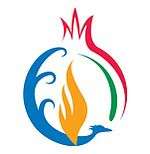
| Years | Manufacturers | Sponsors |
|---|---|---|
| 1980–1986 | Meyba | None |
| 1986–1989 | Puma | None |
| 1989–1990 | Mita | |
| 1990–1993 | Marbella* | |
| 1993–1994 | Antena 3 | |
| 1994–1996 | Marbella* | |
| 1996–1997 | Bandai/Tamagotchi | |
| 1997–1998 | Marbella* | |
| 1998–1999 | Reebok | |
| 1999–2000 | None | |
| 2000–2001 | Idea | |
| 2001–2002 | Nike | |
| 2002–2003 | Century | |
| 2003–2005 | Columbia Pictures** | |
| 2005–2011 | KIA | |
| March–May 2012 | Rixos Hotels (Liga only, except v. R. Madrid) | |
| May–December 2012 | Huawei | |
| 2012–2015 | Azerbaijan Land of Fire | |
| 2013–2015 | Baku 2015 | |
| 2015– | Plus500 |
- (*) – 1990–93, 1994–96, 1997–99 Marbella Tourism Board, as Jesús Gil was mayor of Marbella at this time.
- (**) – 2003–05 Columbia Pictures (Movies advertised on the shirt included: Bewitched, Hollywood Homicide, S.W.A.T., Big Fish, Hellboy, Spanglish, Resident Evil 2: Apocalypse, Hitch, xXx, and the aforementioned Spider-Man 2)
Notable players
Adelardo holds the club's official appearance record, wearing the Atlético shirt in 551 matches from 1959 to 1976., club current player for the team, holds the record for most goals scored with 212 and counting, while Adrián Escudero has the record for most goals in La Liga with 150. Fernando Torres is the club's current record appearance holder, with 182. Radamel Falcao is the club's most expensive signing at €40 million, and at €60 million also its biggest sale.
|
|
Note: All players in the above tables are Spanish, unless otherwise indicated.
See also
- Atlético de Kolkata
- Atlético Madrid B
- Atlético Madrid C
- Trofeo Villa de Madrid
- Atlético Madrid BM
- BM Atlético Madrid
References
- 1 2 http://www.uefa.com/MultimediaFiles/Download/StatDoc/competitions/UEFACup/01/67/59/06/1675906_DOWNLOAD.pdf
- ↑ "Wanda Group is now the owner of 20% of the Club's shareholding". clubatleticodemadrid.com. Atlético de Madrid. March 31, 2015. Retrieved November 7, 2015.
- ↑ "1973/74: Müller ends Bayern wait". UEFA. Archived from the original on 11 October 2010. Retrieved 7 November 2010.
- ↑ "Estadio Vicente Calderón". The Stadium Guide. Archived from the original on 22 November 2010. Retrieved 20 November 2010.
- ↑ "Real Madrid vs Atlético Madrid Derby: Great Local Football Derbies". Eurorivals. Retrieved 20 November 2010.
- 1 2 3 "Classic club". FIFA. Archived from the original on 6 September 2011. Retrieved 20 November 2010.
- ↑ "Atletico Madrid History". Atleticomadrid.azplayers. Archived from the original on 7 July 2011. Retrieved 20 November 2010.
- ↑ "The Atlético Crest and its Meaning – The Offside – Atlético Madrid Spanish La Liga Football Blog". Atletico.theoffside. Archived from the original on 3 November 2010. Retrieved 20 November 2010.
- ↑ "Talking History: Atlético Madrid – This Is Anfield (Liverpool FC)". Thisisanfield. Retrieved 20 November 2010.
- ↑ clubatleticodemadrid.com Archived 25 May 2012 at the Wayback Machine.. clubatleticodemadrid.com. Retrieved 20 November 2010.
- ↑ La Liga History – Football League Archived 6 March 2012 at the Wayback Machine.. Ole Ole (6 April 2009). Retrieved 20 November 2010.
- ↑ Real Madrid Vs. Atletico Madrid. Realatletico.com. Retrieved 20 November 2010.
- ↑ European Cup & Champions League History 1955–2010. Europeancuphistory.com. Retrieved 20 November 2010.
- ↑ European Competitions 1958–59 Archived 12 January 2016 at the Wayback Machine.. Rsssf.com. Retrieved 20 November 2010.
- ↑ 1958/59: Di Stéfano keeps Madrid rolling on Archived 1 May 2013 at the Wayback Machine.. Uefa.com (3 June 1959). Retrieved 20 November 2010.
- ↑ uefa.com – UEFA Cup Winners' Cup Archived 4 September 2015 at the Wayback Machine.. En.archive.uefa.com (1 June 1962). Retrieved 20 November 2010.
- ↑ uefa.com – UEFA Cup Winners' Cup Archived 12 January 2016 at the Wayback Machine.. En.archive.uefa.com. Retrieved 20 November 2010.
- ↑ Enrique Collar, el 11 rojiblanco. Pobreatleti.com. Retrieved 20 November 2010.
- ↑ Adelardo, Adelardo Rodríguez Sánchez. BDFutbol (26 September 1939). Retrieved 20 November 2010.
- ↑ "1973/74: Müller ends Bayern wait –". Uefa.com. 15 May 1974. Retrieved 2013-03-08.
- ↑ European Competitions 1973–74 Archived 6 October 2009 at the Wayback Machine.. Rsssf.com. Retrieved 20 November 2010.
- ↑ European Cup & Champions League History 1955–2010. Europeancuphistory.com. Retrieved 20 November 2010.
- 1 2 1973/74: Müller ends Bayern wait on Archived 11 October 2010 at the Wayback Machine.. Uefa.com (15 May 1974). Retrieved 20 November 2010.
- 1 2 Intercontinental Cup 1974 Archived 4 December 2009 at the Wayback Machine.. FIFA.com. Retrieved 20 November 2010.
- ↑ Intercontinental Club Cup 1974. Rsssf.com. Retrieved 20 November 2010.
- ↑ uefa.com – UEFA Cup Winners' Cup Archived 21 August 2010 at the Wayback Machine.. En.archive.uefa.com (1 June 1986). Retrieved 20 November 2010.
- ↑ European Competitions 1985–86 Archived 27 November 2012 at the Wayback Machine.. Rsssf.com. Retrieved 20 November 2010.
- ↑ "Atletico owner Gil dies". BBC News. 14 May 2004.
- ↑ Futre, Paulo Jorge Dos Santos Futre. BDFutbol (28 February 1966). Retrieved 20 November 2010.
- ↑ Lowe, Sid (3 November 2009). "Are 'madhouse' Atlético Madrid the worst run club in Europe?". The Guardian. London.
- ↑ Raúl González, spanish-fiestas.com
- ↑ Lowe, Sid (18 April 2010). "Atlético Madrid can put end to glory of suffering in Liverpool semi". The Guardian. London.
- ↑ Atletico Madrid Season Needs Flores Formula. Insidefutbol.com (1 December 2009). Retrieved 20 November 2010.
- ↑ Fernando Torres Career. Torres.soccer-profiles.com. Retrieved 20 November 2010.
- 1 2 Torres cuts short holiday, set to join Liverpool Soccernet.espn.go.com (3 July 2007). Retrieved 20 November 2010.
- ↑ Austin, Simon (22 October 2008). "New and improved Forlan to test Liverpool". BBC News.
- ↑ Reyes goes to Atleti, Marca 29 July 2007 (Spanish)
- ↑ "Reyes passes Atletico Madrid medical". Goal. 30 July 2007. Archived from the original on 30 September 2007.
- ↑ The Guardian 30 July 2007
- ↑ European Competitions 1996–97. Rsssf.com. Retrieved 20 November 2010.
- ↑ Javier Aguirre Walks Away From Atletico. TheOriginalWinger.com (3 February 2009). Retrieved 20 November 2010.
- ↑ Abel Resino: Atletico Madrid job dream come true | Spanish Football News Archived 7 February 2009 at the Wayback Machine.. tribalfootball.com. Retrieved 20 November 2010.
- ↑ "Man United flop Forlan bags second Euro Golden Shoe after netting 32 times in La Liga". Daily Mail. London. 31 May 2009.
- ↑ Fletcher, Paul (21 October 2009). "Chelsea 4 – 0 Atletico Madrid". BBC Sport. Retrieved 13 May 2010.
- ↑ "Atletico Madrid sack coach Resino". BBC Sport. 23 October 2009. Archived from the original on 26 October 2009. Retrieved 24 October 2009.
- ↑ Quique to Atletico Madrid. La Liga Weekly (23 October 2009). Retrieved 20 November 2010.
- ↑ Quique Sánchez Flores to be manager at Atlético de Madrid Archived 1 March 2012 at the Wayback Machine.. Typicallyspanish.com (24 October 2009). Retrieved 20 November 2010.
- ↑ "Atletico Madrid coach Quique Sanchez Flores hails players' resolve against Fulham". The Daily Telegraph. London. 13 May 2010.
- ↑ Ornstein, David (29 April 2010). "Liverpool 2 – 1 Atletico Madrid (agg 2 – 2)". BBC Sport. Archived from the original on 12 May 2010. Retrieved 13 May 2010.
- ↑ "Late winner breaks Fulham hearts". ESPNsoccernet. 12 May 2010. Archived from the original on 18 May 2010. Retrieved 13 May 2010.
- ↑ Winter, Henry (12 May 2010). "Fulham 1 Atlético Madrid 2 aet: match report". The Daily Telegraph. HSH Nordbank Arena, Hamburg: Telegraph Media Group. Archived from the original on 15 May 2010. Retrieved 12 May 2010.
- ↑ Report: Atlético Madrid v Sevilla FC – Spanish Copa del Rey – ESPN Soccernet. Soccernet.espn.go.com (20 May 2010). Retrieved 20 November 2010.
- ↑ Wilson, Jonathan (9 May 2012). "Atlético Madrid 3–0 Athletic Bilbao". The Guardian. London.
- ↑ "Atl. Madrid 3–0 Athletic Bilbao: EL champs". Goal.com. 9 May 2012. Retrieved 2013-03-08.
- ↑ "Atletico Madrid upsets Real Madrid to win Copa del Rey". The Associated Press. 17 May 2013.
- ↑ "Football: Atletico stun 10-man Real Madrid to win Spanish Cup". Channel News Asia. Singapore. 17 May 2013. Archived from the original on 7 June 2013.
- ↑ "Chelsea 1–3 Atletico Madrid". BBC Sport. 30 April 2014. Retrieved 30 April 2014.
- ↑ "Chelsea 1 Atlético Madrid 3". Daily Telegraph. 30 April 2014. Retrieved 2 May 2014.
- ↑ Martin, Richard (17 May 2014). "Barcelona 1 Atletico Madrid 1, La Liga: match report". The Daily Telegraph. Retrieved 17 May 2014.
- ↑ "Simply the best - all-time greats final selection", Telegraph, 29 December 2000.
- 1 2 "Evolution 1929–10". Liga de Fútbol Profesional. Archived from the original on 20 July 2011. Retrieved 6 August 2010.
- ↑ "Palmarés en" (in Spanish). MARCA. Retrieved 22 June 2010.
- ↑ Carnicero, José; Torre, Raúl; Ferrer, Carles Lozano (28 August 2009). "Spain – List of Super Cup Finals". Rec.Sport.Soccer Statistics Foundation (RSSSF). Retrieved 22 June 2010.
- ↑ "List of Super Cup Finals". RSSF. Retrieved 18 March 2011.
- ↑ "UEFA Cup Winners' Cup". UEFA. Archived from the original on 1 May 2010. Retrieved 22 June 2010.
- ↑ "UEFA Super Cup". UEFA. Archived from the original on 20 August 2010. Retrieved 22 June 2010.
- ↑ "Paris aim to join multiple trophy winners". Retrieved 15 April 2016.
- ↑ "Primer Equipo" [First team] (in Spanish). Atlético Madrid. Retrieved 3 February 2016.
- ↑ AS Sport newspaper
- ↑ Madrid.es. "Ayuntamiento de Madrid – El Calderón se va al nuevo Estadio olímpico". Madrid.es. Retrieved 20 November 2012.
- ↑ "Atletico Madrid to move to new stadium". 15 December 2008. Archived from the original on 9 March 2009.
- ↑ clubatleticodemadrid.com Archived 8 July 2011 at the Wayback Machine.. clubatleticodemadrid.com. Retrieved 20 November 2010.
- ↑ http://en.rsf.org/azerbaidjan-do-you-know-who-atletico-madrid-s-22-05-2014,46334.html Do you know who Atlético Madrid's real sponsor is?
- ↑ http://www.bbc.co.uk/news/blogs-news-from-elsewhere-27343540 Atletico Madrid: Azerbaijan logo edited out of Iran paper
- ↑ http://www.hfhr.pl/wp-content/uploads/2014/08/List_HFPC_AtleticoMadrid_20082014.pdf
- ↑ "Football sponsors and their marketing strategy". Footballspeak.com. Retrieved 2013-03-08.
- ↑ Baku 2015 secures exposure through Atletico Madrid partnership
External links
| Wikimedia Commons has media related to Atlético de Madrid. |
- Official website (Spanish) (English)
- Atlético de Madrid at La Liga (English) (Spanish)
- Atlético de Madrid at UEFA (English) (Spanish)
.jpg)